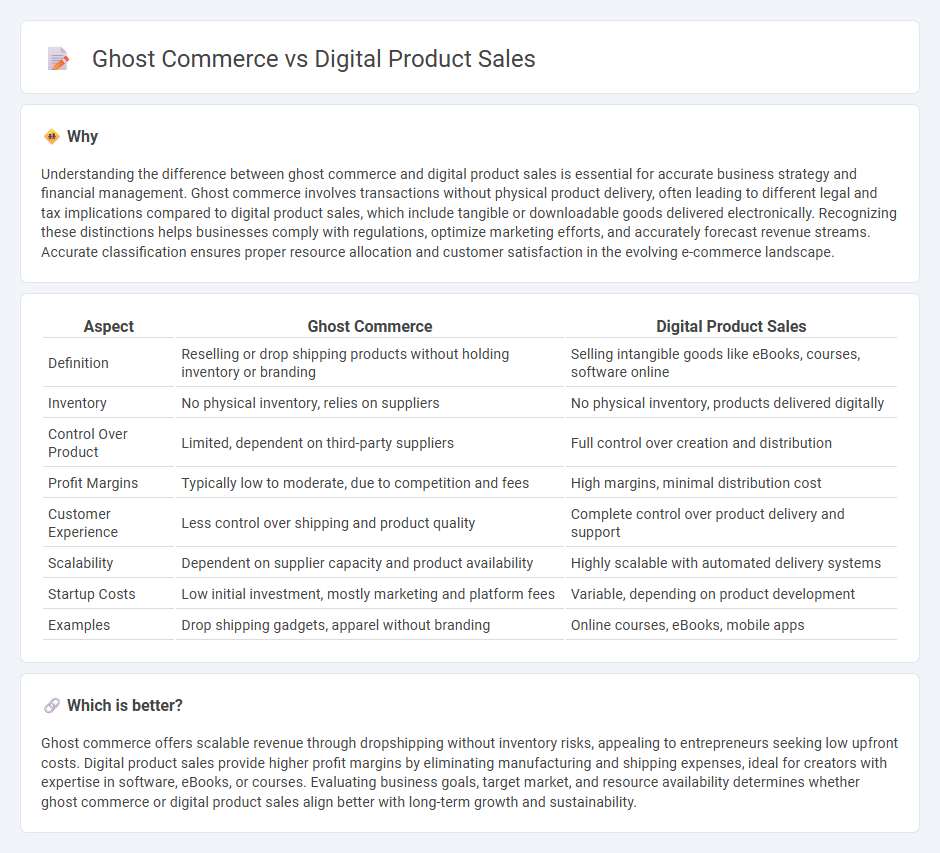
Ghost commerce leverages third-party platforms to sell products without managing inventory or shipping, streamlining operations and reducing overhead costs. Digital product sales focus on delivering intangible goods such as eBooks, software, and online courses directly to consumers, emphasizing instant access and global reach. Explore the nuances of ghost commerce versus digital product sales to optimize your e-commerce strategy.
Why it is important
Understanding the difference between ghost commerce and digital product sales is essential for accurate business strategy and financial management. Ghost commerce involves transactions without physical product delivery, often leading to different legal and tax implications compared to digital product sales, which include tangible or downloadable goods delivered electronically. Recognizing these distinctions helps businesses comply with regulations, optimize marketing efforts, and accurately forecast revenue streams. Accurate classification ensures proper resource allocation and customer satisfaction in the evolving e-commerce landscape.
Comparison Table
| Aspect | Ghost Commerce | Digital Product Sales |
|---|---|---|
| Definition | Reselling or drop shipping products without holding inventory or branding | Selling intangible goods like eBooks, courses, software online |
| Inventory | No physical inventory, relies on suppliers | No physical inventory, products delivered digitally |
| Control Over Product | Limited, dependent on third-party suppliers | Full control over creation and distribution |
| Profit Margins | Typically low to moderate, due to competition and fees | High margins, minimal distribution cost |
| Customer Experience | Less control over shipping and product quality | Complete control over product delivery and support |
| Scalability | Dependent on supplier capacity and product availability | Highly scalable with automated delivery systems |
| Startup Costs | Low initial investment, mostly marketing and platform fees | Variable, depending on product development |
| Examples | Drop shipping gadgets, apparel without branding | Online courses, eBooks, mobile apps |
Which is better?
Ghost commerce offers scalable revenue through dropshipping without inventory risks, appealing to entrepreneurs seeking low upfront costs. Digital product sales provide higher profit margins by eliminating manufacturing and shipping expenses, ideal for creators with expertise in software, eBooks, or courses. Evaluating business goals, target market, and resource availability determines whether ghost commerce or digital product sales align better with long-term growth and sustainability.
Connection
Ghost commerce relies heavily on the sale of digital products by eliminating traditional inventory and shipping costs, enabling entrepreneurs to operate virtually invisible storefronts. Digital product sales, including eBooks, software, and online courses, provide the backbone for ghost commerce business models by offering instant delivery and global reach. The seamless integration of digital payment systems and automated marketing tools accelerates growth within ghost commerce ecosystems.
Key Terms
E-commerce Platform
Digital product sales on e-commerce platforms streamline transactions through instant delivery of items like software, e-books, and online courses, optimizing customer experience and reducing inventory costs. Ghost commerce involves third-party vendors fulfilling orders behind the scenes, allowing e-commerce platforms to offer a vast product range without holding stock, enhancing scalability and operational efficiency. Explore more about how e-commerce platforms leverage these models to maximize revenue and customer satisfaction.
Passive Income
Digital product sales generate passive income by offering scalable, automated revenue streams through eBooks, online courses, and software downloads that require minimal ongoing effort. Ghost commerce involves managing third-party eCommerce stores without inventory, enabling entrepreneurs to profit from existing platforms and customer bases with limited operational responsibilities. Explore effective strategies to maximize passive income through digital products and ghost commerce models.
Dropshipping
Dropshipping eliminates inventory risks by allowing sellers to list digital and physical products directly from suppliers, reducing upfront costs in digital product sales. Digital product sales generate passive income through instant delivery and minimal overhead, contrasting with ghost commerce's reliance on third-party fulfillment for physical goods. Explore deeper insights into dropshipping strategies and digital product optimization for e-commerce success.
Source and External Links
What Are Digital Products? Sell These 11 Products Online (2025) - Provides tips for selling digital products including creating compelling previews, building trust with social proof, and using social media strategically to boost sales and engagement in the digital product market.
How to Sell Digital Products Online in 2025 - BigCommerce - Outlines a six-step action plan for brainstorming, researching, and launching digital product sales, emphasizing low overhead and high potential for ecommerce success.
19 Profitable Digital Products and Where to Sell Them - Thinkific - Highlights the importance of identifying your niche, analyzing market demand, promoting your product effectively, and using SEO and scaling strategies to succeed in selling digital products online.
 dowidth.com
dowidth.com